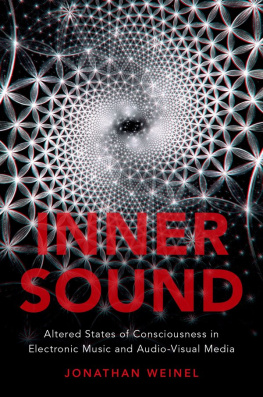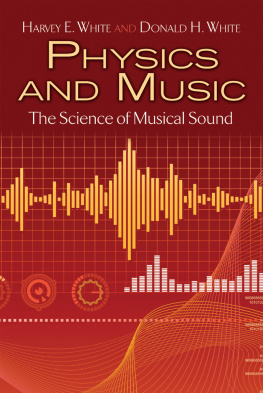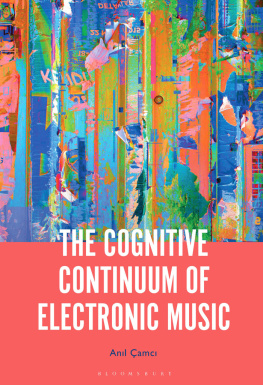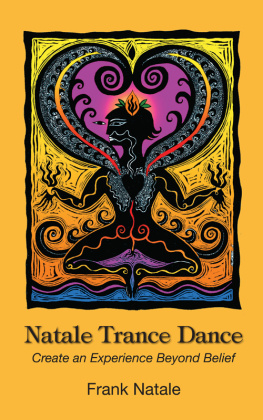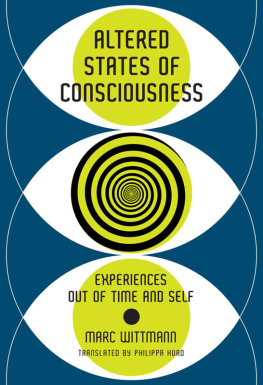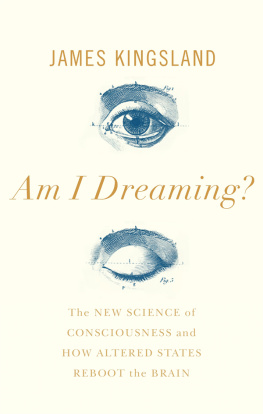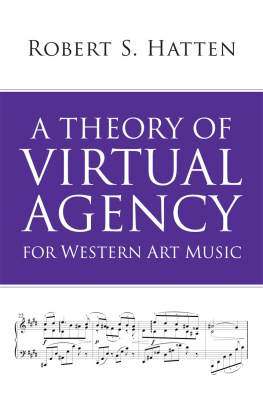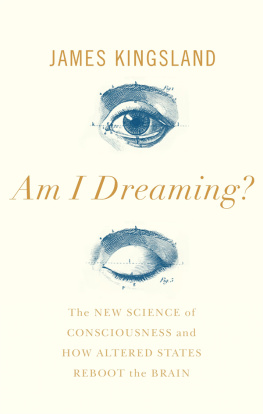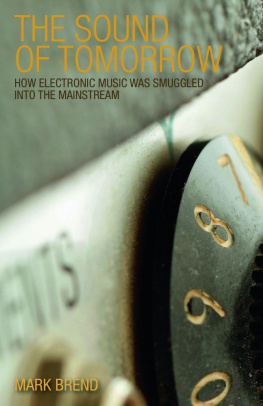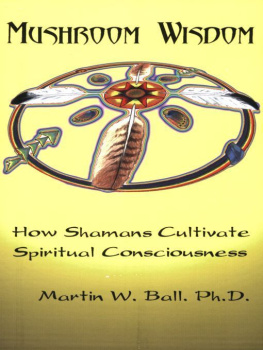Inner Sound

Oxford University Press is a department of the University of Oxford. It furthers the Universitys objective of excellence in research, scholarship, and education by publishing worldwide. Oxford is a registered trade mark of Oxford University Press in the UK and certain other countries.
Published in the United States of America by Oxford University Press
198 Madison Avenue, New York, NY 10016, United States of America.
Oxford University Press 2018
All rights reserved. No part of this publication may be reproduced, stored in a retrieval system, or transmitted, in any form or by any means, without the prior permission in writing of Oxford University Press, or as expressly permitted by law, by license, or under terms agreed with the appropriate reproduction rights organization. Inquiries concerning reproduction outside the scope of the above should be sent to the Rights Department, Oxford University Press, at the address above.
You must not circulate this work in any other form and you must impose this same condition on any acquirer.
Library of Congress Cataloging-in-Publication Data
Names: Weinel, Jonathan, author.
Title: Inner sound : altered states of consciousness in electronic music and audio-visual media / Jonathan Weinel.
Description: New York, NY : Oxford University Press, [2018] |
Includes bibliographical references and index.
Identifiers: LCCN 2017057904 | ISBN 9780190671198 (pbk. : alk. paper) |
ISBN 9780190671181 (cloth : alk. paper) | ISBN 9780190671228 (oxford scholarship online) | eISBN 9780190671211 (epub)
Subjects: LCSH: MusicPsychological aspects. | Altered states of consciousness. |
Electronic musicPsychological aspects. | Electronic dance musicPsychological aspects. |
Motion picturesPsychological aspects.
Classification: LCC ML3838 .W33 2018 | DDC 781.1/1dc23
LC record available at https://lccn.loc.gov/2017057904
ACKNOWLEDGEMENTS
In my earliest memories, I discovered ammonites and danced ecstatically to rock n roll cassettes in Sherborne, Dorset, a small town on the Jurassic coast of the United Kingdom. Although the actual writing of Inner Sound was undertaken over a two-year period, its formation began long before, and as such I would like to thank everyone who helped me to cultivate my interests in music over the years. This includes my friends and family; the Abbey and Gryphon schools; my guitar teacher Roger Cleverley; my lecturers at Keele University, especially Rajmil Fischman, who supervised my PhD in electroacoustic composition; and my tutors at the Open University. The research and writing of the book proper was undertaken at the following institutions: Glyndr University (UK), the British Library (UK), and Aalborg University (Denmark). During this process, I received valuable assistance from my editor at Oxford University Press, Norman Hirschy, and a panel of anonymous peer-reviewers. Additional feedback was also provided from my friends Lyall Williams, Sol Nte, and my partner Jennifer Pickles. All of these inputs were vital in steering Inner Sound towards its final form, and as such are highly valued. Thanks is also due to everyone who provided images for the book, who are credited throughout. Jan Robbe deserves a special mention for creating original digital artworks for the front cover. Lastly, I would like to thank all the other artists and musicians whose work I discuss in the book, especially those who took the time to correspond with me about their work.
CONTENTS
Inner Sound
Immediately before my eyes are a vast number of rings, apparently made of extremely fine steel wire, all constantly rotating in the direction of the hands of a clock; these circles are concentrically arranged, the innermost being infinitely small, almost point-like, the outermost being about a meter and a half in diameter. The spaces between the wires seem brighter than the wires themselves. Now the wires shine like dim silver in parts. Now a beautiful light violet tint has developed in them. As I watch the center seems to recede into the depth of the room, leaving the periphery stationary, till the whole assumes the form of a deep funnel of wire rings.
Anonymous participant, Knauer and Maloney, 1913
psychoactive effects, such as distortions to visual and auditory perception, dissolution of ego boundaries and dimensions of oceanic boundlessness, which may last up to 10 hours.
example, while an individual might perceive geometric funnel patterns in the early stages of a mescaline experience, later on such funnel patterns might assume realistic forms such as actual tunnel environments.
Klvers (1971) work on form constants has since been followed by others, such as Bressloff et al.s (2001) study, which suggested that the forms perceived were the result of patterns, p.133). The artists who created these markings were representing aspects of the visions that they considered to be sacred.
media related to ASCs reflects the ethos of various sub-cultures.
SPIRAL TRIBES
Over the past few millennia humankind has woven an intricate history with intoxicating plants, resulting in various associated artefacts. Exploring this area, ).
While the full details of many of these early examples may have been lost in the sands of time, more recent recorded history provides a clearer impression of the ritual use of hallucinogens. Modern use of the term shaman derives directly from Siberian shamanism and the Tungus word meaning to know ( the shamanic use of mushrooms continues in the Huichol and Mazatec peoples of Mexico, who are descendant from the Aztecs. Elsewhere in North America, Native Americans use peyote, while in South America shamans of the Peruvian Amazon use ayahuasca (or yag); a hallucinogenic brew that contains a natural source of DMT (N,N-dimethyltryptamine, a powerful hallucinogen).
Returning to Europe, prior throughout much of Europe today.
In 1938 Albert Hofmann synthesized LSD, a compound with remarkable hallucinogenic properties. Such drugs came to be known as psychedelic, meaning mind manifesting, as coined by British psychiatrist Humphry Osmond in reference to their powerful consciousness altering capabilities. The use of LSD was initially explored for therapeutic and military purposes during for spiritual purposes.
Throughout history the use of
PSYCHEDELIC ARTEFACTS
It may not come as a surprise that the presence of ASCs in culture over thousands of years has resulted in a great deal of art, literature, and music related, pp.131133).
In modern Western culture, we find further examples of painting and visual art related to ASCs. Beginning in the 1920s, the surrealist art movement explored ideas, pp.3540) also explores these themes, drawing attention to the presence of designs that are similar to Klvers form constants in the work of various visual artists.
In Western literature of the eighteenth and nineteenth centuries, ASC-inspired literary accounts are found in works such as 1975).
Music appears to have a special connection with ASCs. In their respective work, included both mainstream commercial forms and underground counter-culture strains; the latter often remaining explicitly orientated towards psychedelic drug culture.
In the emerging audio-visual culture of the twentieth century, ASC themes also appeared in experimental films such as Storm of detail and sophistication.
Just as the use of ASCs throughout history has occurred in relation to various cultures and systems of belief, so too do these various artefacts reflect differing attitudes towards ASCs. For example, shamanic art and music can be seen as a means to invoke and communicate with the spirit world that ASCs allow one to experience. Romantic literary works such as Kubla Khan (Coleridge, 1797), and later the surrealist movement, can also be seen as responses to a perceived loss of connection with inner experience. Subsequently, the psychedelic art, literature, and music of the 1960s can be seen as part of the counter-culture movement towards expanded forms of consciousness and social revolution. In this context, drugs such as LSD were seen by some as a means through which to achieve revolutionary forms of consciousness, and the associated cultural artefacts embrace this ethos by representing such experiences, or by actually seeking to induce them. Some of these ideas also extended into the electronic dance music culture of the 1980s and 1990s, though here the ethos was frequently a more hedonistic celebration of euphoric drug-induced states. Of course, not all cultural artefacts within these domains celebrate ASCs, and in some cases music and art may avoid these aesthetic approaches, and be seen as sufficiently powerful in its own right. Other examples may also express cautionary tales or present anti-drug positions. This is especially the case in recent mainstream media, where drugs are often viewed in negative terms and used for their shock value; hence some of the most recent films and video games that represent ASCs do so within the context of the horror genre.

